Adolf Hitler
Adolf Hitler | |
|---|---|
 Official portrait, 1938 | |
| Führer of Germany | |
| In office 2 August 1934 – 30 April 1945 | |
| Preceded by | Paul von Hindenburg(President) |
| Succeeded by | Karl Dönitz(President) |
| Chancellor of Germany | |
| In office 30 January 1933 – 30 April 1945 | |
| President | Paul von Hindenburg (1933–1934) |
| Deputy | Franz von Papen (1933–1934) Hermann Göring (1941–1945) |
| Preceded by | Kurt von Schleicher |
| Succeeded by | Joseph Goebbels |
| Führer of the Nazi Party | |
| In office 29 July 1921[1]– 30 April 1945 | |
| Deputy | Rudolf Hess(1933–1941) |
| Preceded by | Anton Drexler(Chairman) |
| Succeeded by | Martin Bormann(Party Minister) |
| Personal details | |
| Born | 20 April 1889 Braunau am Inn,Austria-Hungary |
| Died | 30 April 1945(aged 56) Berlin,Nazi Germany |
| Cause of death | Suicide by gun |
| Citizenship |
|
| Political party | Nazi Party(1921–1945) |
| Other political affiliations | German Workers' Party(1919–20) |
| Spouse(s) | |
| Parents | Alois Hitler Klara Pölzl |
| Occupation | General of Nazi Germany |
| Cabinet | Hitler cabinet |
| Signature | |
| Military service | |
| Allegiance | |
| Branch | Imperial German Army
Reichswehr Wehrmacht |
| Service years | |
| Rank | Gefreiter |
| Unit | 16th Bavarian Reserve Regiment |
| Wars | World War I World War II |
| Awards |
|

Adolf Hitler[2](20 April 1889 – 30 April 1945) was anAustrian-bornGermanpoliticianand the leader of theNazi Partyfrom 1933 until his death in 1945. He and his Nazi government are known for causingWorld War IIandthe Holocaust,which killed millions.
Hitler became the leader of theNazi Partyin 1921. In 1923, he attempted to seize governmental power in afailed coupinMunichand was imprisoned with a sentence of five years. In jail, he dictated the first volume of his autobiography and political manifestoMein Kampf( "My Struggle" ). He led them to become the most powerfulpolitical partyin Germany after the 1932elections.He began running the government when he became theChancellor of Germanyin 1933. The Nazis banned all otherpolitical partiesand turned Germany into adictatorship(meaning that the government was ruled by one person). Hitler's dictatorship is known asNazi Germany,also known as the Third Reich (meaning "Third Empire" or "Third Realm" ). Hitler called himself theFührer(meaning "leader" ) after the year 1934.
Hitler ordered the takeover ofPolandin 1939, and this startedWorld War IIinEurope.Hitler made all the important decisions during the war.[3]At first, Nazi Germany did well in the war, but by 1945 they were losing. On 29 April 1945, Hitler married his longtime lover,Eva Braun,in theFührerbunkerinBerlin.Less than two days later, Hitler and Brauncommitted suicide,as theSoviet Armygot toBerlin,because they did not want to be captured alive by theSoviet Union.
Because of the Nazi government, at least 50millionpeople died.[4]About 28.7 millionsoldiersand people died in the fighting. The war also killed 19.3 millionciviliansandprisoners of war.Nazi forces committed manywar crimesand atrocities during the war.[5]They killed theirenemiessometimes withmobile death squadsor put them inconcentration campsanddeath camps.Hitler and his menpersecutedand killedJewsand otherethnic,religious,andpoliticalminorities.In what is calledthe Holocaust,the Nazis killed six million Jews,Roma people,homosexuals,Slavs,andmany other groups of people.[6]
Family background
Hitler's family was born inWaldviertel,inLower Austria.At the time, the nameHitlerchanged in this region several times betweenHüttler,Hiedler,HittlerandHitler.The name was commonly in theGerman-speaking area ofEuropein the19th century.[7]Theliteraturesays that this name is descended from theCzechnameHidlarorHidlarcek.[8]
Childhood and early adulthood
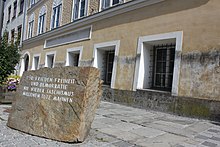
Adolf Hitler was born on 20 April 1889, as the fourth child of six[9]inBraunau am Inn.This is a small town nearLinzin theprovinceof Upper Austria, close to theborderwith Germany. At the time, the town was inAustria-Hungary.His parents wereKlara PölzlandAlois Hitler.Because of his father'sjob,Hitler moved from Braunau toPassau,later toLambachand finally toLeonding.He attended severalVolksschule's.
Hitler's mother, Klara Pölzl, was his father's third wife and also hiscousin.[10]Hitler's father died in 1903. Hitler was born with only one testicle.[11][12]
Hitler failedhigh schoolexamsin Linz twice. In 1905, he left school. He became interested in theanti-Semitic(anti-Jewish),Pan-Germanteachings ofProfessorLeopold Poetsch.In September 1907, he went toViennaand took an entrance examination. On 1 and 2 October, he failed the second examination. Hitler went back to Linz at the end of October. In December 1907, Hitler's mother died and, because of that, he wasdepressed.[13]Hitler's mother wasCatholic,but Hitler is not known to have been personally interested inChristianity.[14]
In 1909, Hitler again went to Vienna to studyart.He tried to become a student at the Academy of Arts, but failed the first entrance examination.[13]He made many paintings and sold them at low prices. Hitler said he first became an anti-Semite in Vienna. This city had a large Jewish community.[15]
In 1913, Hitler was 24 years old. At that time, all young Austrian men had to join thearmy.Hitler did not like the Austrian army and theAustro-Hungarian Empirebecause of its manyethnic groups,so he left Austria for Germany. He lived in the German city ofMunich.[13]
World War I
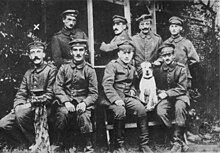
On 16 August 1914, Hitler joined theBavarianarmy. He fought for the German Empire inWorld War I.Hitler served inBelgiumandFrancein the 16th Bavarian Reserve Regiment. He spent nearly the whole time on theWestern Front.He was a runner, one of the most dangerous jobs on the Front.[16]That means he ran from one position to another one to carry messages. On 1 November 1914, Hitler became aGefreiter(which was like being aprivate first classin theUnited States Army,or alance corporalin theBritish Army). The governmentawardedhim theIron CrossSecond Class on 2 December 1914.
On 5 October 1916, Hitler was hurt by abullet shell.Between 9 October and 1 December, he was in themilitaryhospitalBelitz.[17]In March 1917, he went back to the front. There, he fought in abattleand was awarded with theMilitärverdienstkreuz Third Class with swords.
In March 1918, Hitler participated in theSpring Offensive.On 4 August 1918, Hitler was awarded the Iron Cross First Class by theJewishHugo Gutmann. AfterGermany surrendered,Hitler was shocked, because the German army still held enemy area in November 1918.[18]
Entry into politics
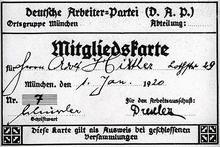
After World War I, Hitler stayed in the army and returned to Munich. There he attended thefuneralmarch of the Bavarianprime ministerKurt Eisner,who had been killed.[19]In 1919, he participated in a training programme forpropagandaspeakers from 5 to 12 June and 26 June to 5 July.
Later that year, Hitler joined a smallpolitical partycalled theGerman Workers Party.He became member number 555.[20]He soon won the support of the party's members. Two years later, he became the party's leader. He renamed the party theNational Socialist German Workers Party.It became known as theNazi Party.
During the Weimar Republic
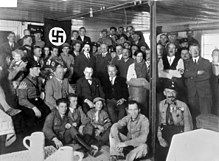
In 1923, Hitler got together several hundred other members of the Nazi Party and tried to take over theWeimar Republicgovernment (1918–34) in theBeer Hall Putsch.[21]Thecoupfailed. The government killed 13 of his men[22](the 13 dead men were later declaredsaintsin Naziideology). They also put Hitler in theLandsberg Prison.They said that he would stay in prison for five years, but they let him leave after nine months.
Mein Kampf

While Hitler was in prison, he wrote a book with the help of his close friendRudolf Hess.At first, Hitler wanted to call the bookFour and a Half Years of Struggle against Lies, Stupidity and Cowardice.In the end, he called the book "Mein Kampf"(" My Struggle ").[23]
Mein Kampfbrought together some of Hitler's different ideas and explains where they came from:[24]
- His idea that the "Aryan race"was better than everybody else: This came fromArthur de Gobineau's book calledThe Inequality of the Human Races.
- His plans for anEmpirein the East: These plans came from the way Germany had captured farming land in the First World War.
- His idea thatdemocracy(rule by governments vote inelections) should be replaced bydictatorship(rule by one man)
- The idea that Judaism andcommunismwere connected: He got this idea from the NaziwriterAlfred Rosenberg.
- His anger against the Jews. He suggests that they should be killed, though he is not clear about how this should be done.[25]
Hitler may also have been influenced byMartin Luther'sOn the Jews and their Lies.InMein Kampf,Hitler says Martin Luther was "a greatwarrior,a truestatesmanand a greatreformer."[15]
Rise to power
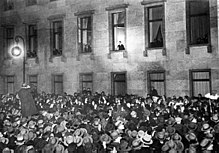
In January 1933, Hitler waselectedinto the German government and became adictatorin the next months. He endedfreedom of speech,freedom of the pressand put his enemies inprisonsandconcentration campsor killed them. He banned every otherpolitical partyexcept the Nazi Party by the summer of 1933 and Germany became aone-party state.[21]Hitler and hispropagandaminister,Joseph Goebbels,spread extremenationalismwithin Germany. Allmediacame under the control of the Nazi Party and they had to praise Hitler and the Nazis. Also, more people were born because Hitler wanted more people of the "master race"(those he called"Aryans"). After the death ofPaul von Hindenburgin 1934, Hitler declared the office of President vacant and made himselfFührer(bothHead of StateandHead of Government) and became a fulldictatorwith nochecks and balances.He made Germany atotalitarianfascistdictatorship.[26]
Hitler was also responsible for theBeer Hall Putsch Of 1923.In theNight of the Long Knives Of 1934he hadErnst Röhmthe head of theSAkilled byHeinrich Himmler,Reinhard Heydrichand theSS.They were also involved in theKristallnacht(1938).
World War II and the Holocaust


Hitler is credited with starting World War II byordering the German Army to invade Poland.[27]His armytook overwestern Poland, and later most ofEurope,includingFranceand a large part of theSoviet Union.
During the war, Hitler ordered the Nazis to kill many people, including women and children. The Nazis killed around six million Jews inthe Holocaust.Other people that the Nazis killedwereRoma(Gypsies),homosexuals,Slavs such asRussiansandPoles,and his political opponents.[28]
Finally,some of the other countries in the worldworked together to defeat Germany. Hitler lost all of the lands that he had taken. Millions of Germans were killed in the war. At the end of World War II, Hitler gave all people in theFührerbunkerpermission to leave it. Many people did and moved to the region ofBerchtesgaden.They usedplanesandtruckconvoys.
Hitler, the Göbbels family,Martin Bormann,Eva Braunand some otherstaffremained in the bunker.[29]Hitler married to Eva Braun on 29 April 1945.
Death
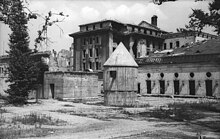
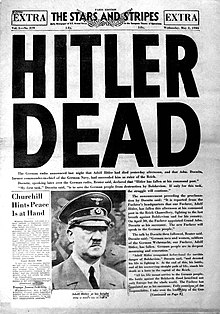
Forty hours after Hitler and Eva Braun got married inBerlin,Germany,both of them committedsuicidebypoisoningthemselves withcyanide,then Hitler shot himself in the head with hisgun.[29]Before this, Hitler ordered that theirbodiesbe burned.[30]This prevented him from being captured alive by soldiers of theRed Army,who were closing in on him. Despite this, there aretheoriesthat Hitler did not die in 1945, but that he instead escaped toArgentina.These theories are very unpopular, with most historians dismissing them.[31]
Hitler in history
Ian Kershaw,ahistorianwho wrote abiography(life story) of Hitler, describes him as a modern symbol ofevil."Never in history has such ruination... been [linked] with the name of one man."[32]However, Kershaw and some other historians believe that it is more important to look at the wider problems in Germany at the time, rather than at Hitler himself, to explain why the war and the Holocaust happened.[33]
Related pages
References
- ↑Evans 2003,p. 180.
- ↑Germanpronunciation:adɔlf hɪtlɐ
- ↑"BBC - History - World Wars: Hitler's Leadership Style".bbc.co.uk.2011.Retrieved27 April2011.
- ↑Both, Owen (1999).Der Zweite Weltkrieg(in German). Kaiser. p. 7.ISBN978-3-7043-6046-5.
- ↑This applies mainly to theSS:theSchutzstaffel,which was the Nazi security and military organisation. The regular army, known as theWehrmacht,was a separate organisation.
- ↑"The Holocaust: an unbelievable tragedy".Archived fromthe originalon 18 October 2002.Retrieved9 January2010.[dead link]
- ↑Jetzinger, Franz (1956).Hitlers Jugend(in German). Europa-Verlag. pp. 11 f.
- ↑Fest, Joachim (1999).Hitler. Eine Biographie. 2. edition(in German). Ullstein. p. 43.
- ↑Bullock, Alan (1962).Hitler: A Study in Tyranny.Penguin Books.ISBN978-0-14-013564-0.
- ↑Ian Kershaw (1998).Hitler 1889–1936.DVA. p. 37.
- ↑Guardian staff."Hitler really did have only one testicle, German researcher claims".The Guardian Nespaper.Retrieved2023-10-15.
- ↑Frisk, Adam."Adolf Hitler had 1 testicle and a really small penis, according to historians".Global News.Retrieved2023-10-15.
- ↑13.013.113.2Toland, John (1977).Adolf Hitler; Biography 1889-1945(in German). Lübbe Verlag.ISBN978-3-8289-0540-5.
- ↑Alan Bullock; Hitler: a Study in Tyranny; HarperPerennial Edition 1991; p218
- ↑15.015.1Hitler, Adolf (2001).Mein Kampf.Mariner Books.ISBN978-0-395-92503-4.
- ↑Bullock, Allan (1962).Hitler: A Study in Tyranny.Penguin Books.ISBN978-0-14-013564-0.
- ↑Hitler, Adolf (2001).Mein Kampf.Mariner Books. pp. 50–51.ISBN978-0-395-92503-4.
- ↑Bullock, Allan (1962).Hitler: A Study in Tyranny.Penguin Books. p. 60.ISBN978-0-14-013564-0.
- ↑"Picture with Adolf Hitler during the march"(in German). Bibliothek der Bayerischen Staatsbibliothek. Archived fromthe originalon 4 June 2007.Retrieved2009-04-24.
- ↑Toland, John (1977).Adolf Hitler; Biography 1889-1945(in German). Lübbe Verlag. p. 131.ISBN978-3-8289-0540-5.
- ↑21.021.1"Biography and facts about Adolf Hitler".Retrieved10 July2009.
- ↑"The Beer Hall Putsch".Chris Trueman.Retrieved10 July2009.
- ↑"Spartacus Schoolnet - Mein Kampf".John Simkin. Archived fromthe originalon 6 March 2010.Retrieved10 July2009.
- ↑Laurence Rees;The Dark Charisma of Adolf Hitler;Ebury Press 2012; pp. 61–62
- ↑Kershaw, 2008, pages, 148-50
- ↑"Nazi Fascism and the Modern Totalitarian State".Gary Grobman.Retrieved13 July2009.
- ↑"The start of World War Two".Steven Schoenherr. Archived fromthe originalon 8 March 2002.Retrieved2009-07-15.
- ↑"Teachers guide - about the Holocaust".University of South Florida.Retrieved2009-07-15.
- ↑29.029.1"Historyplace - The death of Hitler".The History Place.Retrieved2009-07-15.
- ↑"Hitler, Adolf (1889 - 1945) - Credo Reference Topic".credoreference.com.2011.Retrieved6 September2011.
- ↑"Did Hitler escape from his bunker and live in Argentina after WW2? The real history that debunks the conspiracy".HistoryExtra.Archived fromthe originalon 2023-05-08.Retrieved2023-05-08.
- ↑Kershaw, 2000, pages xvii and 841
- ↑Kershaw, 2008, xxxv–xxxvi
More reading
| Definitionsfrom Wiktionary | |
| Mediafrom Commons | |
| News storiesfrom Wikinews | |
| Quotationsfrom Wikiquote | |
| Source textsfrom Wikisource | |
| Textbooksfrom Wikibooks | |
| Learning resourcesfrom Wikiversity | |
- Alan Bullock (1991).Hitler and Stalin: Parallel Lives.HarperCollins.ISBN978-0-679-72994-5.
- Alan Bullock (1991).Hitler: A Study in Tyranny.ISBN978-0-06-092020-3.
- Michael FitzGerald (2006).Adolf Hitler: A Portrait.Spellmount.ISBN978-1-86227-322-1.
- Joachim Fest (2002).Hitler.Harvest Books.ISBN978-0-15-602754-0.
- Ian Kershaw (1999).Hitler 1889-1936: Hubris.W W Norton.ISBN978-0-393-32035-0.
- Lothar Machtan (2001).The Hidden Hitler.Basic Books.ISBN978-0-465-04308-8.
- "Top 25 Adolph Hitler quotes".AZ Quotes.
Other websites
- Mondo Politico Library's presentation of Adolf Hitler's book, Mein Kampf(full text, formatted for easy on-screen reading)
- 1889 births
- 1945 deaths
- Adolf Hitler
- Austrian painters
- Austrian politicians
- Chancellors of Nazi Germany
- Former dictators
- Former Roman Catholics
- German military personnel of World War I
- German military personnel of World War II
- 20th-century German painters
- Hitler family
- Holocaust perpetrators
- Members of the Reichstag (Nazi Germany)
- Members of the Reichstag (Weimar Republic)
- Ministers-President of Prussia
- Austrian war criminals
- German war criminals
- Nazi leaders
- Nazis who committed suicide
- People from Upper Austria
- People with borderline personality disorder
- Politicians who committed suicide
- Presidents of Nazi Germany
- Suicides by firearm in Germany
- Time People of the Year

